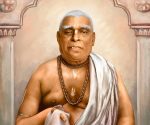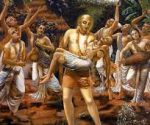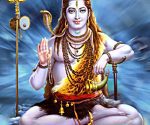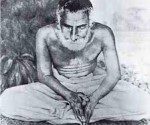Srila Bhaktisiddhanta Sarasvati’s South India Tour
By Srila Bhaktisiddhanata Sarasvati Thakura – from Back to Godhead March/April 2009
In the early 1930s, the intrepid preacher of Krishna consciousness receives grand receptions from the devoted people of South India.
 Srila Bhaktisiddhanta Sarasvati Thakura was the spiritual master of His Divine Grace A. C. Bhaktivedanta Swami Prabhupada. This article is an excerpt from Sri Bhaktisiddhanta Vaibhava, scheduled for publication this year.
Srila Bhaktisiddhanta Sarasvati Thakura was the spiritual master of His Divine Grace A. C. Bhaktivedanta Swami Prabhupada. This article is an excerpt from Sri Bhaktisiddhanta Vaibhava, scheduled for publication this year.
South India, 1930–31 and 1932
Srila Bhaktisiddhanta Sarasvati wanted to install 108 pada-pithas (replicas of Sri Chaitanya Mahaprabhu’s footprints) at sacred locations that had been visited by the Lord, to create awareness of His having been there. But he was able to do so at only eight locations, five of them while touring South India in 1930.1
Advance parties were sent to arrange with local temple authorities for brief and modest installation programs. At each place, accompanied by a small party, Srila Sarasvati Thakura would install a stone imprint representing Mahaprabhu’s feet by washing it with Ganga water, performing arati, reading from the relevant section of Sri Chaitanya-charitamrita, and performing sankirtana. He would give the priests and temple managers funds for the construction of a simple shrine for the footprints, and within a day or two move on.
The expedition began on 23 December 1930, when the party proceeded from Calcutta to Jajpur, Orissa. There Lord Chaitanya’s footprints were installed near the river Vaitarani, also known as Viraja. Lord Chaitanya’s grandfather, Upendra Mishra, was said to have hailed from Jajpur, and Srila Bhaktisiddhanta Sarasvati and his troupe visited the inhabitants of that area who claimed descent from Lord Chaitanya’s family. They also went to see the Varahadeva deity, whose temple was on the other side of the Vaitarani. While crossing, Srila Bhaktisiddhanta Sarasvati commented, “To pass over the Vaitarani means to leave the material habitat and enter Brahmaloka (the spiritual world).”2 On the night of 25 December they left from Jajpur station, at the periphery of thick jungle. When suddenly the sound of tigers was heard, Srila Bhaktisiddhanta Sarasvati asked, “Oh, are the tigers roaring?”
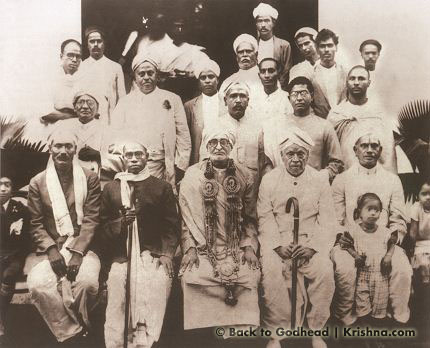
On 26 December the troupe arrived at Kurmakshetra, where the deity of Sri Kurma presides. In the evening, resident brahmanas offered a ceremonial welcome, and after performing a parikrama of the temple, Srila Sarasvati Thakura installed Lord Chaitanya’s footprints. Next the party established pada-pithas at Simhacalam (27 December), Kovvur (29 December), and Mangalagiri (31 December). At Kovvur, by consulting the local public and the description in Sri Chaitanya-charitamrita, an advance party approximately ascertained the site on the bank of the river Godavari at which Sri Chaitanya Mahaprabhu had first met and discussed with Sri Ramananda Raya. For establishing a pada-pitha there, Sripada Bon Maharaja, the leader of the party, selected a suitable plot, which the owner happily donated.
Srila Sarasvati Thakura and company reached Madras on 2 January 1931. The Harmonist described much of the rest of the tour thus:
After a stay of two days at Madras His Divine Grace started for Trivandrum, visiting on the way the temples of Sri Varadaraja at Vishnukanchi, of Sri Ranganathaji at Srirangam, and of Janardana Vishnu at Varkala.3 His Divine Grace reached Trivandrum on 7 January. He next visited Sri Ananta Padmanabha and then proceeded to Tiruvattar, where he saw Sri Adi-keshava. Sri Gaurasundara discovered the manuscript of the Brahma-samhita at this place. His Divine Grace visited Sri Kanyakumari on the ninth. This is the southernmost point of India, otherwise known as Cape Comorin. His Divine Grace returned to Trivandrum the same day and presided at a public lecture delivered in the local Jubilee Hall by His Holiness Srimad Bhakti Hridaya Bon Maharaja of the Gaudiya Mission. His Divine Grace returned to Calcutta on 14 January by way of Madras, where he presided at a second lecture by Swamiji Bon on the life and teachings of Sriman Mahaprabhu, delivered at the local Madhva Association. His Divine Grace had been pleased to visit the residence of Srijut Ramachandra Rao at the town of Rajmahendri, at his earnest prayer. This gentleman had made a free gift of some valuable lands at Kovvur for the erection of the shrine of the footprints of the Supreme Lord, in commemoration with His meeting with Raya Ramananda at that place in 1510 A.D. His Divine Grace was hospitably received on behalf of the Travancore State and provided with a suitable residence during his short stay at Trivandrum, at the Padma Vilasa Palace.4
Srila Sarasvati Thakura commented that the deity of Kanyakumari, after which the township was named, resembled that of Chaitanya Mahaprabhu at Sri Chaitanya Matha, and that although Kanyakumari was generally accepted to be Durga prior to her marriage with Lord Shiva, Vaishnavas consider her to be Lakshmi, daughter of the ocean, on whose shore she resides. He said that just as Kurukshetra is the place of the elder gopis, Kanyakumari is that of the unmarried gopis, and here vipralambha-bhava is triple that in Puri.5
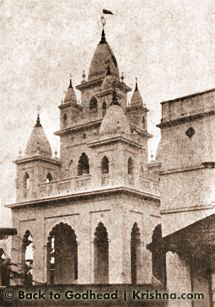 Returning to Bengal prior to the Navadvipa-dhama Parikrama, Srila Bhaktisiddhanta Sarasvati remained in North India for almost a year before again heading for Madras (this time with twenty devotees), where he was accorded several formal receptions, the one conducted upon his arrival being unprecedented. Organized by members of the public in conjunction with the Municipal Corporation, it consisted of local traditional music parties, a brass band, kirtana groups, a procession of Boy Scouts, and throngs of people, many waving flags and festoons and all straining to see and hear this extraordinary saint from Bengal. Thirty-two guns were fired in Srila Bhaktisiddhanta Sarasvati’s honor, and troops led by Britishers were deployed to regulate the crowd. All the important newspapers of the city covered the reception and Srila Bhaktisiddhanta Sarasvati’s subsequent activities in Madras. On 11 January 1932, under the heading “Gaudiya Matha Guru Maharaja in Madras,” the Justice reported:
Returning to Bengal prior to the Navadvipa-dhama Parikrama, Srila Bhaktisiddhanta Sarasvati remained in North India for almost a year before again heading for Madras (this time with twenty devotees), where he was accorded several formal receptions, the one conducted upon his arrival being unprecedented. Organized by members of the public in conjunction with the Municipal Corporation, it consisted of local traditional music parties, a brass band, kirtana groups, a procession of Boy Scouts, and throngs of people, many waving flags and festoons and all straining to see and hear this extraordinary saint from Bengal. Thirty-two guns were fired in Srila Bhaktisiddhanta Sarasvati’s honor, and troops led by Britishers were deployed to regulate the crowd. All the important newspapers of the city covered the reception and Srila Bhaktisiddhanta Sarasvati’s subsequent activities in Madras. On 11 January 1932, under the heading “Gaudiya Matha Guru Maharaja in Madras,” the Justice reported:
His Divine Grace Paramahamsa Sarasvati Goswami Maharaja, the great Acharya of the Gaudiya cult and President of Sri Vishva-Vaishnava-raja Sabha, arrived in Madras yesterday by the Calcutta Mail.
His Holiness’s party consisted of about thirty persons and included the secretary of the said sabha; his private secretary; the editor of the Gaudiya; Prof. J. Dasadhikary, Bhakti-Sastri; Prof. H. P. Mandal; and Mr. G. C. Deb, Retd. Deputy Supdt. of Allahabad.
His Holiness was honored and garlanded on the way at Cuttack Station by the residents of the city, at Rajahmundry, Kovvur, and Basin Bridge.
At Central Station, His Divine Grace was received with shouts of glory by many eminent citizens, and the members of the Madras Gaudiya Matha. As soon as the Svamiji got down, B. H. Bon Maharaja introduced to him the President of the Madras Corporation, T. S. Ramaswami Iyer; the Hon’ble Minister Mr. P. T. Rajan; S. V. Ramaswami Mudaliar; and the Hon’ble Dewan Bahadura S. G. Narayanswami Chettiar, C.I.E.; and they garlanded the Svamiji.
His Divine Grace got into the very beautifully decorated car, and in a huge sankirtana procession consisting of tridandi-swamis, brahmacharis, gentries of the city, provincial scouts, several kirtana parties, and the devotees from Calcutta, started from the front of the Madras Club and slowly proceeded to Gaudiya Matha, Gopalapuram, passing through West Cott’s Road, Woods Road, Rayapettah Bazar Road, Lloyd Road, and Corn Smith Road.
Besides the distinguished gentlemen who received the Goswami Maharaja at Central Station, the inhabitants of Rayapettah, Mylapure, and Gopalapuram received the great Acharya at the corner of Pycrofts Road, and Hon’ble Minister Dewan Bahadura S. Kumarswami Reddiar accompanied His Divine Grace to the Matha itself. The whole procession party with the Svamiji Maharaja got into the new site of the Gaudiya Matha, and then again his car stopped at the gate of the house of his disciples at Lloyd Road, where His Divine Grace was duly honored by the whole family with arati, etc.
Then Guru Maharaja alighted from the car, and was conducted to the decorated “Sri Krishna Hall” of the Matha, where Prof. L. N. Govindarajan of Loyola College, on behalf of the residents of Gopalapuram colony, read an address of homage to His Divine Grace.
The Hon’ble Minister Dewan Bahadura S. Kumarswami Reddiar also addressed, on behalf of the greater population of the province, and paid homage to Paramahamsa Maharaja. The Acharya then gave a suitable and short reply to them.6
On 23 January, Srila Sarasvati Thakura revealed the service of Sri Sri Guru-Gauranga–Gandharvika-Giridhari in the Madras Gaudiya Matha. On 27 January the governor of Madras Presidency, His Excellency Sir George Frederick Stanley, accompanied by Lady Beatrix and his private and military secretaries, came to the Madras Gaudiya Matha and laid the foundation stone for its Sri Krishna Kirtana Hall. His Excellency observed:
In spite of the very short time in which the Mission has been established in Madras, it has obviously made great headway; it has attracted many influential men to its fold and has succeeded in finding a permanent site on which to expand. I wish to say what a great pleasure it is for me to meet today the spiritual head of the Mission, the President Acharya, and I pray that his work and all the members of the Mission may be blessed by the divine grace which inspires them, and that they may ever progress toward their object of bringing peace to India and all mankind.7
Many South Indian Vaishnava brahmanas, themselves deeply learned in shastra, highly regarded Srila Sarasvati Thakura and his disciples for their adherence to sastra and spreading Vishnu-bhakti. Reciprocally, Srila Sarasvati Thakura and his followers esteemed the numerous Vaishnava brahmanas in South India who strictly upheld their culture and principles.
Srila Sarasvati Thakura expressed a desire to preach extensively in South India, considering it a place of devotion due to the widespread influence of Ramanujacharya and Madhvacharya. He appreciated the people’s piety and their developed philosophical sense, but regretted the prevalence of monism. He wanted big Gaudiya Vaishnava temples constructed there. He once said, “I will come again to pick up those disciples of mine who do not complete their bhajana and go back to Godhead. At that time I shall simultaneously fulfill my desire to preach in South India and Vrindavana, and will establish many pada-pithas of Chaitanya Mahaprabhu.” He said that in South India people know arcana but not kirtana, and that they know Vishnu forms of the Lord such as Vasudeva, Kurma, Nrisimha, and Narayana, but not Radha-Krishna.8 However, in a lecture given in Bengal he stated:
The most merciful Sri Chaitanyadeva preached all over South India the glories of Radha-Govinda. Yet today the people there are in the same condition as before Sriman Mahaprabhu came. Therefore it is again required to preach to South Indians, to revive their original consciousness, because they have completely forgotten whatever Sriman Mahaprabhu had instructed. They say, “We are rational and intelligent men, not sentimental like Bengalis,” but they have no interest to hear about Sri Sri Radha-Govinda. When we installed the deity of Radha-Govinda in our Ramananda Gaudiya Matha in South India, local people opposed us and placed so many obstacles. They wanted us to instead install the four-armed form of Lord Vishnu. The people of Madras are busy with discussions of Partha-sarathi and do not know about Radha-Govinda–lila.9 They are very unfortunate; they have no qualification to see the beautiful service of the Supreme Lord that was inaugurated in North India by Sri Chaitanya Mahaprabhu’s associates the Six Goswamis.10
While visiting Madras, Srila Sarasvati Thakura gave insights into his vast knowledge of shastra and Vedic culture by explaining to his disciples salient points about the dress of South Indian brahmanas, who characteristically wore a veshti as lower cloth, and a cotton wrap across the shoulders or tied at the waist, with the rest of the chest and back bare except for an upavita.11 He said that previously the upavita was not used, only the dhoti and upper cloth, but later it became acceptable for brahmanas to wear an upavita instead of an upper cloth. When the Bengali devotees expressed surprise that South Indian brahmanis wore their saris with a kaccha, Srila Sarasvati Thakura stated that this was the correct Vedic method.
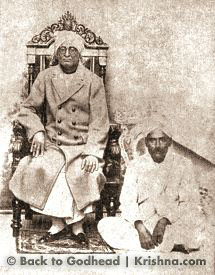 After being offered Vyasa-puja in Madras, Srila Sarasvati Thakura headed back toward Bengal to attend the festival culminating on Gaura-jayanti. En route he halted for another rousing reception, this time in Ellore, a town in the Madras Presidency. Led by zamindar Rao Bahadura Mothi Gangaraju, practically the entire populace feted the acharya with a gala procession of elephants, horses, a band, and hundreds carrying flags, festoons, and ceremonial spears. Seated in a lavishly bedecked horse-drawn coach, Srila Sarasvati Thakura passed through packed streets under continuous showers of flowers. At the conclusion of the parade, he was accorded a highly enthusiastic reception by different religious associations, each presenting him with panegyrics and certificates of appreciation.
After being offered Vyasa-puja in Madras, Srila Sarasvati Thakura headed back toward Bengal to attend the festival culminating on Gaura-jayanti. En route he halted for another rousing reception, this time in Ellore, a town in the Madras Presidency. Led by zamindar Rao Bahadura Mothi Gangaraju, practically the entire populace feted the acharya with a gala procession of elephants, horses, a band, and hundreds carrying flags, festoons, and ceremonial spears. Seated in a lavishly bedecked horse-drawn coach, Srila Sarasvati Thakura passed through packed streets under continuous showers of flowers. At the conclusion of the parade, he was accorded a highly enthusiastic reception by different religious associations, each presenting him with panegyrics and certificates of appreciation.
Shortly thereafter, Srila Bhaktisiddhanta Sarasvati again visited South India, stopping briefly in Madras before proceeding to Coimbatore and several other towns, eventually reaching the hill station Ootacamund, where he took relief from the heat of the plains. Remaining there over two months, he sometimes lectured but mostly concentrated on writing—revising Professor Sanyal’s English book Sree Krishna Chaitanya, working on the English translation of Brahma-samhita, completing his own Gaudiya-bhashya on Sri Chaitanya-bhagavata, and penning an English booklet about Sri Ramananda Raya. On the arrival of the cooling monsoonal rains he journeyed to Mysore, reaching there on 17 June 1932 to fulfill an invitation from the Maharaja of Mysore, Sir Krishna Rajendra Udaiyar Bahadura. The maharaja was well known as being, like his father before him, adept in both Eastern and Western philosophy and a liberal sponsor of Hindu causes, with particular admiration for the Ramakrishna Mission. Srila Bhaktisiddhanta Sarasvati was honored as a state guest and lodged in the fabulous Rama Palace. The maharaja arranged and attended public meetings at the palace, which featured speeches by Srila Bhaktisiddhanta Sarasvati.
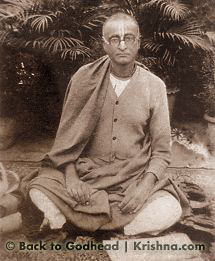 While in Mysore, Srila Sarasvati Thakura pointed out that in the far west of Mysore District was situated Sringeri, where impersonalist Sripada Sankaracharya had established a matha; diametrically opposite, in the far east of the district at Mulbagal, a matha had been founded by Sri Vadiraja of the Madhva sampradaya, whose upholding of Shuddha-dvaita-siddhanta directly opposed Sankaracharya’s teachings; and since Mysore city is exactly midway between the two locations, it is fitting to at this place present Lord Chaitanya’s achintya-bhedabheda-tattva, which being the midpoint of unqualified monism and unrelenting dualism, harmonized both stances, bringing to a perfect conclusion the strengths of both.
While in Mysore, Srila Sarasvati Thakura pointed out that in the far west of Mysore District was situated Sringeri, where impersonalist Sripada Sankaracharya had established a matha; diametrically opposite, in the far east of the district at Mulbagal, a matha had been founded by Sri Vadiraja of the Madhva sampradaya, whose upholding of Shuddha-dvaita-siddhanta directly opposed Sankaracharya’s teachings; and since Mysore city is exactly midway between the two locations, it is fitting to at this place present Lord Chaitanya’s achintya-bhedabheda-tattva, which being the midpoint of unqualified monism and unrelenting dualism, harmonized both stances, bringing to a perfect conclusion the strengths of both.
In an entry dated 21 June 1932 in the visitor’s book of the maharaja’s Sanskrit college, Srila Bhaktisiddhanta Sarasvati wrote:
Visited H.H. Maharaja’s Sanskrit College on 20-6-32 and was very kindly received and shown over the premises by the worthy principal. We had a look at the famous collection of Sanskrit manuscripts and had a short talk with the professors of the college. We were impressed by the atmosphere of liberal all-round culture of the place and the cordiality of our reception by the instructional staff and students. We could not help feeling the absence of a chair of Srimad-Bhagavatam embodying the highest synthesis of religion in its comparative aspects.
Bhaktisiddhanta Sarasvati
Patraraja12, Sri Vishva-Vaishnava-raja Sabha
Sri Chaitanya Matha, Sri Mayapur
Nadia, Bengal
After ten days in Mysore the next stop was Trivandrum, where the Maharaja of Travancore also received Srila Sarasvati Thakura and his party as state guests. He personally guided Srila Sarasvati Thakura around the magnificent Ananta Padmanabha temple, and heard from him about the teachings of Lord Chaitanya in relation to those of the Vaishnava acharyas of South India.
Bhakti Vikasha Swami, originally from England, is an ISKCON sannyasi, guru, and author. He spends most of his time in India, teaching Krishna consciousness.
NOTES
1. Several more such pada-pithas have since been established by discipular descendants of Srila Sarasvati Thakura.
2. The river Vaitarani that surrounds hell is manifested on the earthly plane as this namesake in Orissa. The prototype Vaitarani is described in Srimad-Bhagavatam 5.26.22: “A person born into a responsible family—such as a kshatriya, a member of royalty, or a government servant—but who neglects to execute his prescribed duties according to religious principles and thus becomes degraded, falls down at the time of death into the river of hell known as Vaitarani. This river, which is a moat surrounding hell, is full of ferocious aquatic animals. When a sinful man is thrown into the river Vaitarani, the aquatic animals there immediately begin to eat him, but because of his extremely sinful life, he does not leave his body. He constantly remembers his sinful activities and suffers terribly in that river, which is full of stool, urine, pus, blood, hair, nails, bones, marrow, flesh, and fat.”
Worldly people come to Jajpur to perform rituals whereby they can be freed from sinful reactions that could cause their incarceration in the hellish Vaitarani.
The prototype Viraja described in scripture is at the border of the material world and must be crossed before entering the spiritual realm. Viraja means vigata-raja (raja: material world; vigata: without). (See Chaitanya-charitamrita, Madhya 21.50)
3. Vishnukanchi: a neighborhood within the temple town Conjeevaram (Kanchipuram).
4. Harmonist 28.280 (February 1931).
5. The connection between Kanyakumari and the unmarried gopis (Vraja-kumaris) is that the latter prayed to Katyayani, who is nondifferent from Kanyakumari, to attain Krishna as their spouse.
6. Quoted in Harmonist 29.256 (February 1932).
7. Justice, 26 January 1932; quoted in Harmonist 29.286 (March 1932).
8. The statements in this and the previous paragraph were given by Jati Sekhara Prabhu.
9. Partha-sarathi: a name of Krishna meaning “charioteer of Arjuna.”
10. Srimad Bhagavata-tatparya 69.
11. Veshti: a dhoti worn double-folded and without a kaccha (the length tucked in at the back).
12. Patraraja: president.




